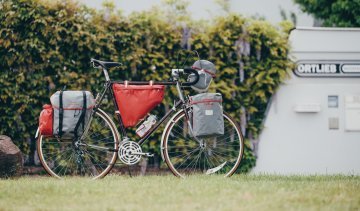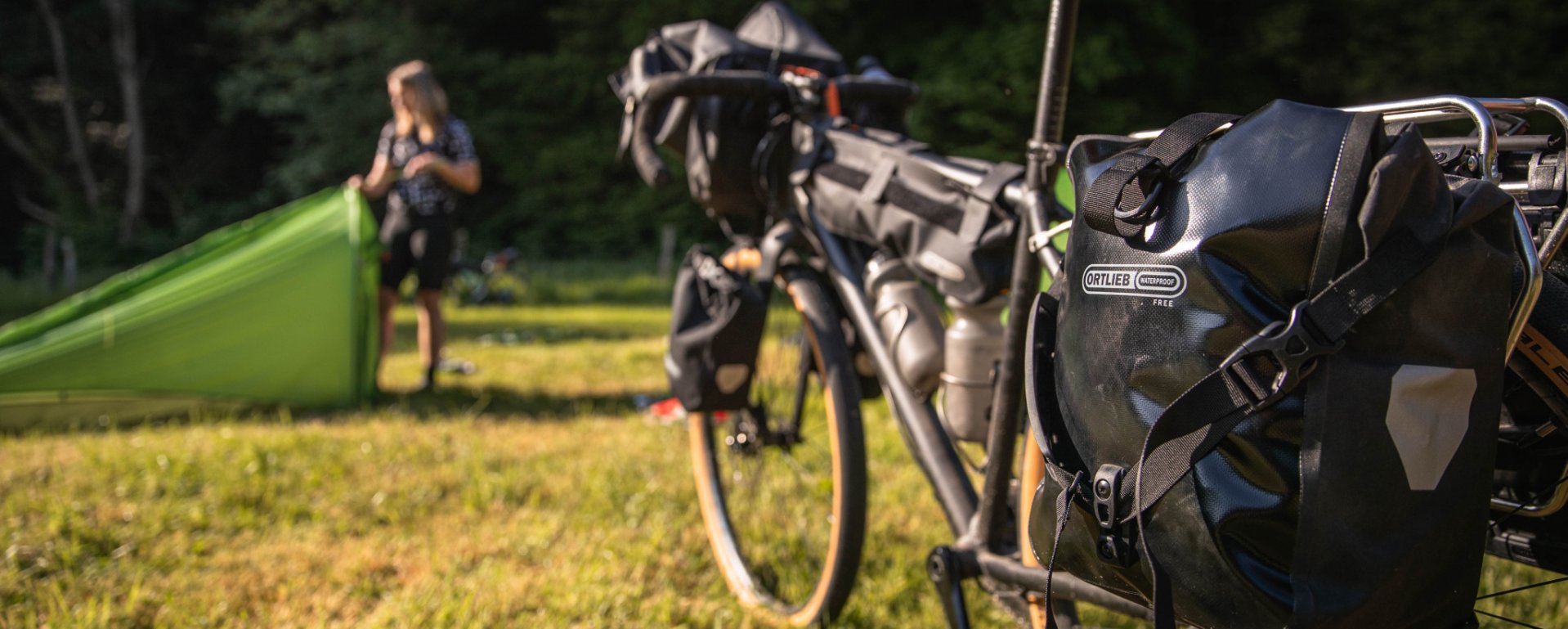
On the Road with bc: The ORTLIEB Factory Tour. ...
Andi visited the bicycle bag specialist ORTLIEB in Heilsbronn. A factory tour and a bike overnighter were on the agenda.
Get on your bike and go! With the right bag setup, nothing stands in the way of a bikepacking adventure. Here’s what you need to know.
Bikepacking is booming! More and more people are discovering this type of sporty cycling excursion with a minimal amount of luggage for themselves. No wonder, as it's a wonderful feeling to strap a few things onto the bike and just cycle away or to be on the road for one or more days at once. Bikepacking is about leaving your everyday life behind, enjoying nature and literally just getting out. If you enjoy discovering your surroundings in this way, it is worth investing in special equipment such as good bikepacking bags to make your tours easier. Unlike “normal” bike trips, the concept of bikepacking is to take as little as possible and distribute the weight optimally on your bike. This helps you make better progress over the long haul, and keeps you in control of your bike even when riding across difficult terrain. We’ll give you an overview of which bikepacking bags are out there, which will help you put together your perfect setup.
When it comes to bikepacking, saddle bags don’t mean the little pouches that hold your repair kit and house keys for your after-work road bike ride. Rather, they are essential storage for your equipment. Bikepacking saddlebags are available in different sizes - you will usually find several options ranging between 6 and 16 litres. They offer enough storage space for clothes or bedding materials. Panniers are usually attached to the seatpost with one or two wide hook & loop straps and to the seat stays with straps to prevent them from swinging sideways while riding. Incidentally, packing bags correctly is also crucial: heavier items on the inside, lighter items on the outside, is the rule of thumb. Elastic drawstrings on the pocket also allow you to strap on a rain jacket or windbreaker on the outside. In addition, many seat packs have one or more tabs at the back, to which you can attach something, such as a rear light. To pack efficiently, some seat packs and panniers are equipped with a valve that allows you to compress the pack volume. Since the saddlebag on road bikes and MTBs is exposed to dirt from the rear wheel, it should definitely be waterproof. Pay attention if you use a dropper seatpost: the attachment of the seat pack can scratch the sliding surface of the post. The Valais 25 saddle bag holder from Wolf Tooth Components provides a solution. In addition, you should also make sure not to operate the post by mistake.
In principle, the seat packs consist of a bag with roll closure and the holder. You can choose between several kinds of seat packs. On one-piece models, integrated straps attach to the pannier, and a reinforced bottom provides good support as well as better packability. With two-piece systems you attach a harness or holster to the seatpost and seat stays, which remains on the bike. It holds the pannier, which you can remove with one or two clicks of the buckle to access your luggage. Other models are also two-piece but do not have a holster, and instead consist of a pannier which includes a fastening system and a waterproof inner bag.
Handlebar bags for bikepacking, also known as handlebar rolls because of their shape, are constructed according to the same principle and can hold, for example, a minimalist sleeping bag, a sleeping mat or your tent. Robust panniers can be attached to your handlebars either with a holster or directly with the straps. This allows you to remove the bag or load or unload it directly on the bike. The roll fasteners are at both ends, so you can easily access your things. For extra space, for example for tools or your rain gear, accessory packs are handlebar bag extensions that you can strap onto the handlebar bag or use as a stand-alone bag. With spacers made of foam, you can adapt the caster to your handlebar. Nevertheless, you should first measure the width of your handlebars and your preferred bag. It must not restrict shifting and braking or grip positions, nor should it press on the cables.
Some things, such as your mobile phone, power bank, money or bars, you need more often on the road than your sleeping bag or toiletry kit. Here you can attach a top tube bag to the top tube, either in front of the seatpost or in front of the headset, using hook & loop fasteners or screws. Depending on the setup you ride, or how many things you want to store, you can choose between different sizes and types. For example, there are models that have a cable opening so that you can charge your bike computer or your light comfortably while riding with a power bank. A particularly large amount of space is offered by two-piece top tube bags, which consist of a holder and a removable pannier, and are suitable, for example, as shoulder bags for shopping. Another option for quickly and securely attaching individual small items while bikepacking are smaller plastic straps. They are very resilient and stretchy, and can be fitted almost anywhere on your bike frame.
Especially if you are riding longer distances, it is important to provide your body with enough calories. Cylindrical snack bags, which usually have a drawstring closure, are a good choice for reaching into bags of gummy bears or trail mix on the go. Since they are attached to the right and/or left of the stem, they are also called stem bags or, because they are usually used for provisions, food pouches. Of course, drink bottles, bars or whatever you prefer to have handy also fit in well. Even compact cameras are adequately protected. Make sure that the stem bags do not restrict the steering angle of your bike too much!
Frame bags are mounted inside the front frame triangle. There are long versions that strap under the top tube and different sized ones in triangular shapes - the largest ones completely fill the frame triangle. They are particularly suitable for transporting somewhat heavier or bulky objects low down in the wheel, such as gas cartridges, cooking pots or tent poles. Which model you choose also depends on the size of your bike and the frame shape. You should measure beforehand so that the pockets fit exactly. You also have to decide whether you want to use the drink bottle and frame bag together or alternatives such as a backpack with a drink bladder. Even with larger bikes, you may not be able to reach your drink bottles properly with a frame bag. Here, a bottle adapter will help you optimally position your bottle cage. Some bicycle manufacturers, such as Salsa, also offer frame bags specially tailored to their models.
Even if it seems as if bikepacking requires using only special panniers, you can of course also use cargo rack systems which let you hook on waterproof panniers or attach them with an integrated quick-release fastener. It is important that your setup meets your requirements and that weight is evenly distributed on the bike. You can also choose cargo racks and dry bags which you attach with tension straps. Particularly popular are front cargo racks called ”Pizza Racks”, which are called that because they are the size of a pizza box. If your bike has appropriate eyelets on the fork, you can also mount a Lowrider. It ensures favourable load distribution thanks to its low centre of gravity and is usually compatible with bags from various manufacturers. If your bike doesn’t have eyelets or has a suspension fork, models which you can attach to the fork or rear wheel stays with strong, flexible webbing are suitable.
Another type are mounts which are specially designed for the fork, which you can attach either with eyelets or with clamps. Their cylindrical, half-open shape is ideal for carrying round equipment items such as a sleeping bag, sleeping mat or small dry bags, which are fixed in place with tension straps. German bag manufacturer ORTLIEB has also developed fork bags that you can attach to an adapter plate using a special Quick-Lock System. Not all cargo rack systems fit every bike - for example, some are not suitable for carbon frames, others for suspension forks - so you should always check beforehand whether your bike meets the manufacturer's specifications.
